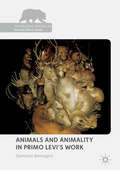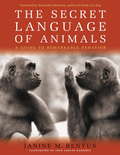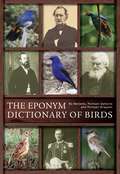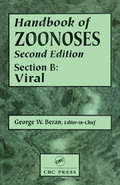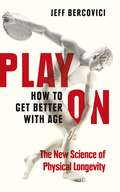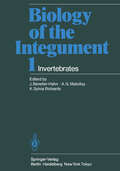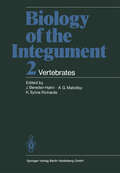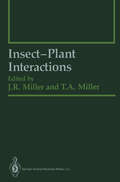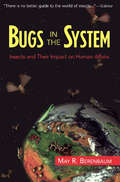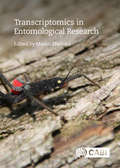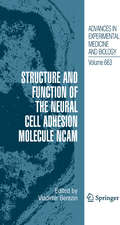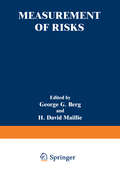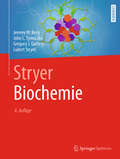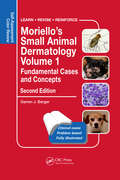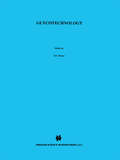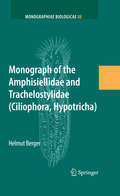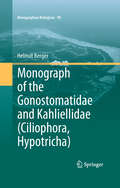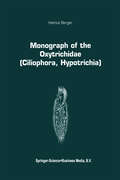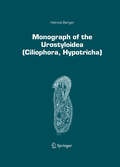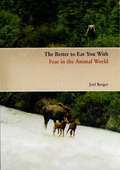- Table View
- List View
Animals and Animality in Primo Levi’s Work (The Palgrave Macmillan Animal Ethics Series)
by Damiano BenvegnùSituated at the intersection of animal studies and literary theory, this book explores the remarkable and subtly pervasive web of animal imagery, metaphors, and concepts in the work of the Jewish-Italian writer, chemist, and Holocaust survivor Primo Levi (1919-1987). Relatively unexamined by scholars, the complex and extensive animal imagery Levi employed in his literary works offers new insights into the aesthetical and ethical function of testimony, as well as an original perspective on contemporary debates surrounding human-animal relationships and posthumanism. The three main sections that compose the book mirror Levi’s approach to non-human animals and animality: from an unquestionable bio-ethical origin (“Suffering”); through an investigation of the relationships between writing, technology, and animality (“Techne”); to a creative intellectual project in which literary animals both counterbalance the inevitable suffering of all creatures, and suggest a transformative image of interspecific community (“Creation”).
Secret Language of Animals: A Guide to Remarkable Behavior
by Janine M. BenyusUnlock the secrets behind the behavior of the world's most fascinating creatures-from the Adélie penguin to the plains zebra to the giant panda-in this wonderfully written, beautifully illustrated book.In The Secret Language of Animals, biologist Janine Benyus takes us inside the animal kingdom and shows us the whys and the hows behind the distinctive behavior of creatures great and small in their natural environments.Divided geographically into five sections-Africa, Asia, North America, the oceans, and the poles-the book examines and describes the behavior, body language, and patterns of communication of 20 different animals: the gorilla, lion, African elephant, plains zebra, black rhinoceros, giraffe, ostrich, greater flamingo, Nile crocodile, giant panda, peacock, Komodo monitor, bottlenose dolphin, California sea lion, gray wolf, bald eagle, sandhill crane, beluga whale, polar bear, and Adélie penguin.For each animal, Benyus describes and explains basic behaviors (locomotion, feeding, drinking, bathing, grooming, sleeping), communication behavior (greeting, social play, group defense, conflict, aggression/submission, fighting, courtship, copulation), and parenting behavior (birth, care and feeding, teaching, communal care).The book is illustrated throughout with tender yet precise line drawings that beckon us to the animals and vividly capture everything from changing facial expressions to nurturing postures to playful and aggressive interactions. The text, too, is both intimate and informative, allowing for a deep connection with, and a great admiration for, each one of the animals.
Secret Language of Animals: A Guide to Remarkable Behavior
by Janine M. BenyusUnlock the secrets behind the behavior of the world's most fascinating creatures-from the Adélie penguin to the plains zebra to the giant panda-in this wonderfully written, beautifully illustrated book.In The Secret Language of Animals, biologist Janine Benyus takes us inside the animal kingdom and shows us the whys and the hows behind the distinctive behavior of creatures great and small in their natural environments.Divided geographically into five sections-Africa, Asia, North America, the oceans, and the poles-the book examines and describes the behavior, body language, and patterns of communication of 20 different animals: the gorilla, lion, African elephant, plains zebra, black rhinoceros, giraffe, ostrich, greater flamingo, Nile crocodile, giant panda, peacock, Komodo monitor, bottlenose dolphin, California sea lion, gray wolf, bald eagle, sandhill crane, beluga whale, polar bear, and Adélie penguin.For each animal, Benyus describes and explains basic behaviors (locomotion, feeding, drinking, bathing, grooming, sleeping), communication behavior (greeting, social play, group defense, conflict, aggression/submission, fighting, courtship, copulation), and parenting behavior (birth, care and feeding, teaching, communal care).The book is illustrated throughout with tender yet precise line drawings that beckon us to the animals and vividly capture everything from changing facial expressions to nurturing postures to playful and aggressive interactions. The text, too, is both intimate and informative, allowing for a deep connection with, and a great admiration for, each one of the animals.
The Eponym Dictionary of Birds
by Bo Beolens Michael Watkins Michael GraysonBirdwatchers often come across bird names that include a person's name, either in the vernacular (English) name or latinised in the scientific nomenclature. Such names are properly called eponyms, and few people will not have been curious as to who some of these people were (or are).Names such as Darwin, Wallace, Audubon, Gould and (Gilbert) White are well known to most people. Keener birders will have yearned to see Pallas's Warbler, Hume's Owl, Swainson's Thrush, Steller's Eider or Brünnich's Guillemot. But few people today will have even heard of Albertina's Myna, Barraband's Parrot, Guerin's Helmetcrest or Savigny's Eagle Owl. This extraordinary new work lists more than 4,000 eponymous names covering 10,000 genera, species and subspecies of birds. Every taxon with an eponymous vernacular or scientific name (whether in current usage or not) is listed, followed by a concise biography of the person concerned. These entries vary in length from a few lines to several paragraphs, depending on the availability of information or the importance of the individual's legacy. The text is punctuated with intriguing or little-known facts, unearthed in the course of the authors' extensive research.Ornithologists will find this an invaluable reference, especially to sort out birds named after people with identical surnames or in situations where only a person's forenames are used. But all birders will find much of interest in this fascinating dictionary, an ebook to dip into time and time again whenever their curiosity is aroused.
The Eponym Dictionary of Birds
by Bo Beolens Michael Watkins Michael GraysonBirdwatchers often come across bird names that include a person's name, either in the vernacular (English) name or latinised in the scientific nomenclature. Such names are properly called eponyms, and few people will not have been curious as to who some of these people were (or are).Names such as Darwin, Wallace, Audubon, Gould and (Gilbert) White are well known to most people. Keener birders will have yearned to see Pallas's Warbler, Hume's Owl, Swainson's Thrush, Steller's Eider or Brünnich's Guillemot. But few people today will have even heard of Albertina's Myna, Barraband's Parrot, Guerin's Helmetcrest or Savigny's Eagle Owl. This extraordinary new work lists more than 4,000 eponymous names covering 10,000 genera, species and subspecies of birds. Every taxon with an eponymous vernacular or scientific name (whether in current usage or not) is listed, followed by a concise biography of the person concerned. These entries vary in length from a few lines to several paragraphs, depending on the availability of information or the importance of the individual's legacy. The text is punctuated with intriguing or little-known facts, unearthed in the course of the authors' extensive research.Ornithologists will find this an invaluable reference, especially to sort out birds named after people with identical surnames or in situations where only a person's forenames are used. But all birders will find much of interest in this fascinating volume, a book to dip into time and time again whenever their curiosity is aroused.
Handbook of Zoonoses, Section B: Viral Zoonoses
by George W. BeranThis multivolume handbook presents the most authoritative and comprehensive reference work on major zoonoses of the world. The Handbook of Zoonoses covers most diseases communicable to humans, as well as those diseases common to both animals and humans. It identifies animal diseases that are host specific and reviews the effects of various human diseases on animals. Discussions address diseases that remain important public and animal health problems and the techniques that can control and prevent them.The chapters are written by internationally recognized scientists in their respective areas of disease, who work or have worked extensively in the most affected areas of the world. The emphasis for each zoonosis is on the epidemiology of the disease, the clinical syndromes and carrier states in infected animals and humans, and the most current methods for diagnosis and approaches to control. For infectious agents or biologic toxins, which may be transmitted by foods of animal origin, a strong focus is placed on food safety measures. The etiologic and therapeutic aspects of each disease important to epidemiology and control are identified.
Play On: How to Get Better With Age
by Jeff BercoviciHow do the world's best athletes combat ageing, and what you can do to keep up?"Encouraging reading for jocks who are late to the game but committed to the win all the same." Kirkus Review "An energetic romp" that "smartly separates science from quackery." Publishers WeeklySports are about challenging our physical limits. But the greatest limit of all remains undefeated: age. Not, though, for the likes of Roger Federer, Tom Brady and Jo Pavey. What are they doing that you can too?Play On teaches us that it's not aging that causes a decline in fitness; rather, a decline in fitness causes aging.Full of cutting-edge science, technology and practical tips, Play On empowers you to reverse the ageing process, and stay younger for longer.
Biology of the Integument: Invertebrates
by J. Bereiter-Hahn A. G. Matoltsy K. S. RichardsThe integument plays an important role in the survival of meta zoans by separating and protecting them from a hostile environ ment. Its function ranges from protection against injury and in fection; partlcipation in the regulation of body temperature and water balance, to respiratory activity, monitoring of the environ ment and production of signals related to behaviour. All these result from specific structural, biochemical and physiological properties of intra-and extracellular components of the integu ment. Thus its characterization can be best accomplished by a multidisciplinary approach with authors specialized in different fields of science. This multi-author book, in two volumes, provides an up-to date survey of the literature. The first volume deals with the integument of invertebrates, the second with that of vertebrates, both organized primarily on a phylum basis. As the level of knowledge on the integument of phyla differs considerably, the information provided is correspondingly either limited or con densed. For some of the smaller groups of invertebrates little information is available, as often only a few electron micrographs are to be found in the literature; on the other hand, from the large body of knowledge existing for vertebrates, particularly for mammals, no complete overview can be provided, but publica tions giving access to further information have been reviewed critically.
Biology of the Integument: 2 Vertebrates
by J. Bereiter-Hahn A. G. Matoltsy K. S. RichardsThe integument plays an important role in the survival of meta zoans by separating and protecting them from a hostile environ ment. Its function ranges from protection against injury and in fection, participation in the regulation of body temperature and water balance, to respiratory activity, monitoring of the environ ment and production of signals related to behaviour. All these result from specific structural, biochemical and physiological properties of intra-and extracellular components of the integu ment. Thus its characterization can be best accomplished by a multidisciplinary approach with authors specialized in different fields of science. This multi-author book, in two volumes, provides an up-to date survey of the literature. The first volume deals with the integument of invertebrates, the second with that of vertebrates, both organized primarily on a phylum basis. As the level of knowledge on the integument of phyla differs considerably, the information provided is correspondingly either limited or con densed. For some of the smaller groups of invertebrates little information is available, as often only a few electron micrographs are to be found in the literature ; on the other hand, from the large body of knowledge existing for vertebrates, particularly for mammals, no complete overview can be provided, but publica tions giving access to further information have been reviewed critically.
Insect-Plant Interactions (Springer Series in Experimental Entomology)
by M. Berenbaum S. Finch J. L. Frazier F. J. Hanke F. E. Hanson I. Ishaaya M. Kogan I. Kubo A. C. Lewis S. B. Opp R. J. Prokopy M. C. Singer W. M. Tingey H.F. van EmdenThe authoritative overviews in this volume provide a wealth of practical information on current approaches to the study of insect-plant interactions. Methods described include direct behavioral observation; assays of host finding, oviposition, and feeding behavior of insect herbivores; post-ingestion physiological effects; measurement of food quality and sensory responses of insects to plant stimuli; chemical isolation and identification of active phytochemicals; evaluation of plant resistance to insects; and the biochemistry of allelochemic interactions.
Bugs In The System: Insects And Their Impact On Human Affairs
by May R. BerenbaumAn introduction to insect physiology, genetics and behaviour which looks at the interaction between humans and insects, and explores both the positive and negative aspects of the relationship.
Transcriptomics in Entomological Research
by May R Berenbaum Bernarda Calla Joanna C. Chiu Jürgen Ehlting Melanie Gee Aman Gill Martin Hasselmann Matthew Huff Brian R Johnson Juan Luis Jurat-Fuentes William E Klingeman Kyle M. Lewald Shanlin Liu Antonino Malacrinò Guanliang Meng Yoonseong Park Amber Rose Paulson Steven J Perlman Ratnasri Pothula Sampurna Sattar Margaret E Staton James P Tauber Gary A Thompson Patrick Von Aderkas Will Kipling Chengran ZhouBridging the gap between genome and phenotype, the transcriptome is a molecular-level snapshot of the act of living. Transcriptomics shows which genes are expressed into proteins in a specific tissue of a specific organism at a specific time and condition. This book gives an account of the extraordinary diversity of ways transcriptomics has been and can be utilised in basic and applied entomological research. It encompasses a vast range of disciplines within entomology, applying transcriptomics to the study of over one million described species of insects. It covers a vast range of disciplines from phylogenomics to pest management, from ecology to physiology, and from behavior to evolutionary biology. The book covers the breadth and depth of transcriptomics use in research to showcase the utility of this technology in all disciplines. Research examples in the book are relevant to fish, birds, plants, and fungi, as well as insects and other arthropods, helping scientists in any field, using any system, to understand what transcriptomics can do for them. The book: Introduces transcriptomics theory and practice for researchers of all levels wishing to gain an insight into how to apply these techniques to their own fields. Showcases the myriad ways transcriptomics can be used to answer biological questions. Is written by a team of international experts describing their own experiences, giving guidance for applying it to the reader's own work. Reviews how transcriptomics research has helped entomologists push their fields further and make new discoveries.
The Wombles Collection: A 6 Book Bundle
by Elisabeth BeresfordMeet the original recyclers, the Wombles of Wimbledon Common, as they make good use of the rubbish humans throw away.For the first time, read all the Wombles stories in one. Follow the young Wombles as they take their first steps outside the Womble burrow to collect rubbish in the big wide world. Marvel at Tobermory's incredible inventions from what humans would consider 'trash'. And discover a whole Womble community as they head off around the world for even more adventures. This collection contains all six of the Wombles books, beautifully illustrated by Nick Price:The WomblesThe Wandering WomblesThe Wombles at WorkThe Invisible Womble and Other StoriesThe Wombles to the RescueThe Wombles Go Round the World
Structure and Function of the Neural Cell Adhesion Molecule NCAM: Structure And Function Of The Neural Cell Adhesion Molecule Ncam (Advances in Experimental Medicine and Biology #663)
by Vladimir BerezinThis book describes recent developments concerning structural, functional and possible therapeutic aspects of one particular CAM, the neural cell adhesion molecule (NCAM).
Stryer Biochemie
by Jeremy M. Berg John L. Tymoczko Gregory J. Gatto jr. Lubert Stryer„Oft kopiert, nie erreicht.“ Biologen heuteSeit vier Jahrzehnten prägt dieses außergewöhnliche Lehrbuch weltweit die Lehre der Biochemie. Die überaus klare und präzise Art der Darstellung, die Aktualität, die ausgefeilte Didaktik und die Verständlichkeit sind zu Markenzeichen dieses von Lehrenden wie Lernenden hoch geschätzten Standardwerkes geworden. Sie zeichnen auch die nun vorliegende achte Auflage aus, die erneut die Brücke von den biologischen und chemischen Grundlagen zu den physiologischen und medizinischen Fragestellungen schlägt. Zu den wichtigsten Neuerungen und Verbesserungen der vollständig überarbeiteten Neuauflage zählen:Kapitel 5: erweiterte Darstellung von Massenspektrometrie, Proteinmasse, Proteinidentität und ProteinsequenzKapitel 9: neuer Abschnitt zu krankheitsauslösenden Mutationen in Hämöglobingenen, neue Fallstudie zu ThalassämienKapitel 13: neue Fallstudie zu Proteinkinase-A-Mutationen und Cushing Syndrom Kapitel 14: erweiterte Darstellung zu Vorstufen von Verdauungsenzymen und zur Proteinverdauung im Dünndarm, neue Fallstudien zu Proteinverdauung im Magen und zur ZöliakieKapitel 15: neuer Abschnitt zu den Grundfunktionen des Energiestoffwechsels, erweiterte Darstellung zu Phosphaten in biochemischen ProzessenKapitel 16: neue Fallstudien zu exzessiver Fructoseaufnahme und zu schnellwachsenden Zellen und aerober GlykolyseKapitel 29: neue Fallstudien zu Phosphatidylcholin, zur Regulation des LDL-Rezeptor-Kreislaufs und zum klinischen Management von CholesterinwertenKapitel 30: neue Fallstudie zu Blutspiegelwerten der Aminotransferase als diagnostischer PrädiktorStimmen zu früheren Auflagen:Der Stryer ist der "Goldstandard" für Biochemie-Lehrbücher. Prof. Dr. Michael Rychlik, TU MünchenAktuell, didaktisch hervorragend präsentiert, bietet der "Stryer" einen umfassenden Überblick über das Feld und ist als Nachschlagewerk unverzichtbar. Prof. Dr. Dieter Adam, Universität KielDieses Lehrbuch gibt Studierenden am Anfang ihrer Ausbildung einen hervorragenden Einstieg in die Biochemie, ist aber genauso für Fortgeschrittene ideal. Prof. Dr. Mike Boysen, Universität GöttingenDer Klassiker, er ist und bleibt in der Breite und Tiefe und seinem sehr guten didaktischen Aufbau unübertroffen! Ein Muss für jeden Studierenden und Dozenten im Umfeld biomedizinischer Studiengänge. Prof. Dr. Robert Fürst, Universität FrankfurtTrotz der unglaublichen Detailfülle vermittelt der Stryer Verständnis für die Zusammenhänge in der Biochemie. Prof. Dr. Katja Gehrig, Universität Mainz Biochemie anschaulich gemacht: So sollte ein Lehrbuch sein … Dieses Buch nimmt jedem Studierenden die Angst vor der Biochemie! Prof. Dr. Wolf-Michael Weber, Universität MünsterAls Lehrbuchautor packt einen beim Studium des Stryer der Neid. So schöne Fotos, so gekonnte, bunte, eingängige Zeichnungen, soviel Grips, so wenige Fehler. Laborjournal
Moriello's Small Animal Dermatology Volume 1, Fundamental Cases and Concepts: Self-Assessment Color Review, Second Edition (Veterinary Self-Assessment Color Review Series)
by Darren BergerKaren Moriello's seminal book has been completely updated in an effort to create a true two-volume set highlighting fundamental and advanced concepts. This revised fundamental edition includes all new cases and nearly 300 new images. The guide uses a case-based format to deliver a general overview of dermatology of the dog and cat, providing a reference that mirrors the way veterinarians will encounter different scenarios at random in real-life practice. It uses self-assessment problems to review the most common skin diseases encountered every day, plus some more obscure diseases that a veterinarian will face.
Moriello's Small Animal Dermatology Volume 1, Fundamental Cases and Concepts: Self-Assessment Color Review, Second Edition (Veterinary Self-Assessment Color Review Series)
by Darren BergerKaren Moriello's seminal book has been completely updated in an effort to create a true two-volume set highlighting fundamental and advanced concepts. This revised fundamental edition includes all new cases and nearly 300 new images. The guide uses a case-based format to deliver a general overview of dermatology of the dog and cat, providing a reference that mirrors the way veterinarians will encounter different scenarios at random in real-life practice. It uses self-assessment problems to review the most common skin diseases encountered every day, plus some more obscure diseases that a veterinarian will face.
Glycotechnology
by E. G. Berger H. Clausen Richard D. CummingsGlycotechnology brings together in one place important contributions and up-to-date research results in this fast moving area. Glycotechnology serves as an excellent reference, providing insight into some of the most challenging research issues in the field.
Monograph of the Gonostomatidae and Kahliellidae (Monographiae Biologicae #90)
by Helmut BergerThe present monograph is the fourth of six volumes which review the Hypotricha, a major group of the spirotrichs. The book is about the Gonostomatidae, the Kahliellidae, and some taxa of unknown position in the hypotrichs. Gonostomum was previously misclassified in the Oxytrichidae because its type species Gonostomum affine has basically an 18-cirri pattern, which is dominant in the oxytrichids. A new hypothesis, considering also molecular data, postulates that this 18-cirri pattern evolved in the last common ancestor of the hypotrichs and therefore it appears throughout the Hypotricha tree. The simple dorsal kinety pattern, composed of only three bipolar dorsal kineties, and gene sequence analyses strongly suggest that Gonostomum branches off rather early in the phylogenetic tree. Thus, the Gonostomatidae, previously synonymised with the oxytrichids, are reactivated to include the name-bearing type genus and other genera (e.g., Paragonostomum, Wallackia, Cladotricha) which have the characteristic gonostomatid oral apparatus. The Kahliellidae are a rather vague group mainly defined via the preservation of parts of the parental infraciliature. The kahliellids preliminary comprise, besides the name-bearing type genus Kahliella, genera such as Parakahliella and its African pendant Afrokahliella or the monotypic Engelmanniella. In total 68 species distributed in 21 genera and subgenera are revised. As in the previous volumes almost all morphological, morphogenetic, molecular, faunistic, and ecological data, scattered in almost 700 papers, are compiled so that the four volumes (Oxytrichidae, Urostyloidea, Amphisiellidae and Trachelostylidae, Gonostomatidae and Kahliellida) provide a detailed insight into the biology of almost 500 species of hypotrichs. The series is an up-to-date overview about this highly interesting taxon of spirotrichous ciliates mainly addressed to taxonomists, cell biologists, ecologists, molecular biologists, and practitioners.
Monograph of the Urostyloidea (Monographiae Biologicae #85)
by Helmut BergerThis is the second book of a series treating the hypotrichs, a major part of the spirotrichous ciliates. It summarises 230 years of morphological, morphogenetic, faunistic, and ecological data, heretofore scattered in some 1,300 references around the world. The book provides taxonomists, cell biologists, and ecologists with a thorough survey supplying synonyms, nomenclature and systematics, and an extensive description of morphology and ecology, including almost all published records, for each species.
The Better to Eat You With: Fear in the Animal World
by Joel BergerAt dawn on a brutally cold January morning, Joel Berger crouched in the icy grandeur of the Teton Range. It had been three years since wolves were reintroduced to Yellowstone after a sixty-year absence, and members of a wolf pack were approaching a herd of elk. To Berger’s utter shock, the elk ignored the wolves as they went in for the kill. The brutal attack that followed—swift and bloody—led Berger to hypothesize that after only six decades, the elk had forgotten to fear a species that had survived by eating them for hundreds of millennia. Berger’s fieldwork that frigid day raised important questions that would require years of travel and research to answer: Can naive animals avoid extinction when they encounter reintroduced carnivores? To what extent is fear culturally transmitted? And how can a better understanding of current predator-prey behavior help demystify past extinctions and inform future conservation? The Better to Eat You With is the chronicle of Berger’s search for answers. From Yellowstone’s elk and wolves to rhinos living with African lions and moose coexisting with tigers and bears in Asia, Berger tracks cultures of fear in animals across continents and climates, engaging readers with a stimulating combination of natural history, personal experience, and conservation. Whether battling bureaucracy in the statehouse or fighting subzero wind chills in the field, Berger puts himself in the middle of the action. The Better to Eat You With invites readers to join him there. The thrilling tales he tells reveal a great deal not only about survival in the animal kingdom but also the process of doing science in foreboding conditions and hostile environments.
The Better to Eat You With: Fear in the Animal World
by Joel BergerAt dawn on a brutally cold January morning, Joel Berger crouched in the icy grandeur of the Teton Range. It had been three years since wolves were reintroduced to Yellowstone after a sixty-year absence, and members of a wolf pack were approaching a herd of elk. To Berger’s utter shock, the elk ignored the wolves as they went in for the kill. The brutal attack that followed—swift and bloody—led Berger to hypothesize that after only six decades, the elk had forgotten to fear a species that had survived by eating them for hundreds of millennia. Berger’s fieldwork that frigid day raised important questions that would require years of travel and research to answer: Can naive animals avoid extinction when they encounter reintroduced carnivores? To what extent is fear culturally transmitted? And how can a better understanding of current predator-prey behavior help demystify past extinctions and inform future conservation? The Better to Eat You With is the chronicle of Berger’s search for answers. From Yellowstone’s elk and wolves to rhinos living with African lions and moose coexisting with tigers and bears in Asia, Berger tracks cultures of fear in animals across continents and climates, engaging readers with a stimulating combination of natural history, personal experience, and conservation. Whether battling bureaucracy in the statehouse or fighting subzero wind chills in the field, Berger puts himself in the middle of the action. The Better to Eat You With invites readers to join him there. The thrilling tales he tells reveal a great deal not only about survival in the animal kingdom but also the process of doing science in foreboding conditions and hostile environments.
